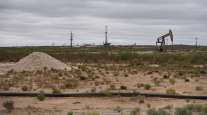Speed Limits May Not Stop Fiery Oil Spills, Rail Chief Says

Lower speed limits for railroads may be ineffective at keeping oil trains on the tracks and preventing massive fireballs, such as those triggered in a series of recent derailments, the chief U.S. railroad regulator said.
“If you’re going to slow trains down, you’re going to have to slow them down to 12 miles an hour,” Sarah Feinberg, acting chief of the Federal Railroad Administration, told reporters in Washington March 13.
“And then you would just have other dangers. People queuing up at grade crossings while train car after train car of volatile product goes by,” she said. “That’s not good either.”
A surge in U.S. oil production has increased the amount of crude moved by rail 5,000% since 2009, much of it from North Dakota’s booming Bakken field. A corresponding jump in accidents, including a 2013 oil-train derailment and explosion that killed 47 people in Lac-Megantic, Quebec, have led U.S. and Canadian regulators to propose tougher standards for trains.
Speeds higher than 25 mph were “irresponsible” given the known weakness of the tank cars carrying the crude, Jim Hall, a former chairman of the National Transportation Safety Board, said in written comments to the Transportation Department.
Hall was responding to a proposed department rule that would require the current fleet of tank cars to be replaced. A draft is being reviewed at the White House Office of Management and Budget and is expected to be final in May.
The Federal Railroad Administration also is studying whether slower speeds can cause a sloshing effect in tank cars, making it harder to prevent the rolling stock from wobbling off the tracks, Feinberg said.
Railroads have lobbied against new limits, saying they would result in costly delays for many of the goods hauled by rail.
Two oil-trains that derailed in the past four weeks, in West Virginia and Illinois, and created massive fireballs were traveling well below federal speed limits, Feinberg said.
Railroads last year agreed to slow trains to 40 mph from 50 mph when carrying crude through High Urban Threat Areas, a designation that covers more than three dozen U.S. communities.
“We are running out of things that I think we can ask for the railroads to do, and there have to be other industries that have skin in the game,” Feinberg said. “There also has to be attention placed on the product actually going into the railcar.”
In April, a regulation in North Dakota that requires oil to be kept at a vapor pressure below 13.7 pounds per square inch goes into effect. Feinberg said a process known as conditioning, which companies can use to meet that standard, is the “bare minimum” step to lower volatility.
Feinberg said the administration is considering further steps to reduce oil’s explosiveness before its loaded into tank cars, though the draft rule under review is silent on the issue.




